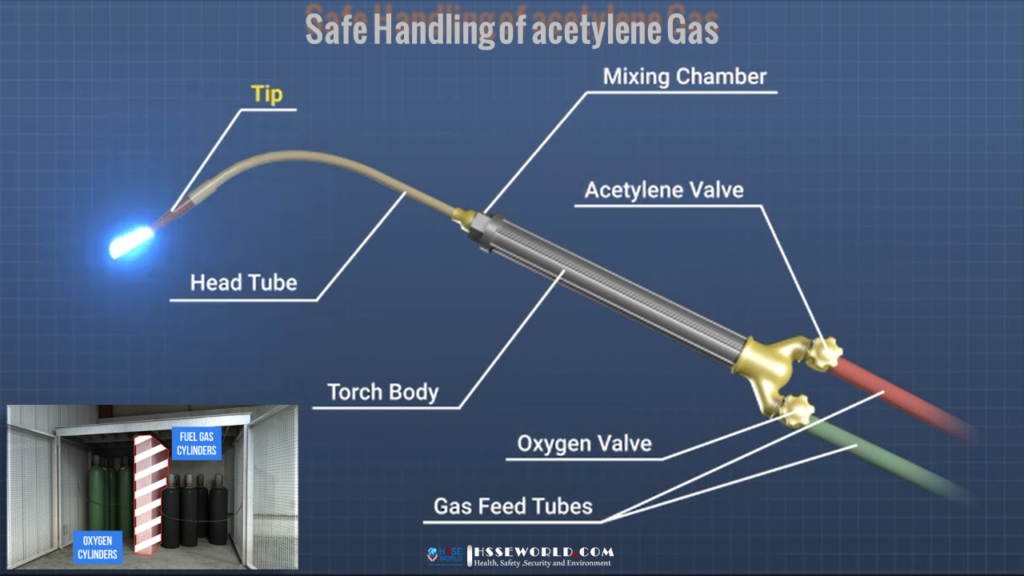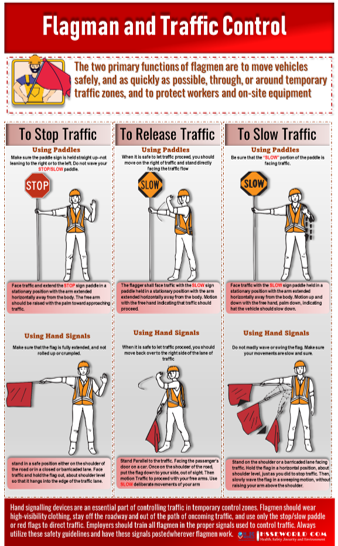Acetylene gas is a highly useful substance, widely found in industrial applications and a mainstay in many hobbyists’ private workshops and garages. Its characteristics make it useful in “oxy-fuel” welding and cutting, but also uniquely dangerous to work with if you don’t understand the hazards.
Safely working with any substance starts with a cursory knowledge of the substance itself. A copy of the safety data sheet (SDS) is a great place to start, and it can be easily found using the common name or the Chemical Abstracts Service (CAS) number 74-86-2. The SDS will give you a great overview of the general precautions and safety measures involved in working with acetylene but is not a stand-in for proper training and supervision.

A basic overview of the chemical characteristics helps understand how the substance will behave and the hazards that can come from handling it:
- Acetylene is a simple alkyne hydrocarbon with a vapor density of 0.9, meaning it is marginally lighter than air and will rise slightly. More likely, it’ll mix with the surrounding air and remain more or less in place unless it is moved mechanically.
- Due to its triple-bond chemical structure, acetylene produces a uniquely energetic flame, reaching the highest flame temperature of all common hydrocarbons. Combustion with oxygen can produce flames up to 3,500°C (6,332°F)!
- Under pressure, acetylene can undergo a decomposition process, yielding hydrogen and carbon soot or “lampblack.” This reaction also generates heat and pressure, which can spell disaster for compressed gas cylinders. For this reason, acetylene is usually dissolved in acetone and stored in a porous medium that hinders decomposition.
Asphyxiation Risk
The American College of Governmental Industrial Hygienists (ACGIH) and OSHA list no established toxicity for acetylene other than a mild anesthetic effect. The gas is, however, a “simple asphyxiant,” meaning that it can displace air and create an atmosphere deficient in oxygen. Combine that with the fact that it either has no odor at all or a faint garlic-y smell, and leaks may be both hazardous and inconspicuous.
If the oxygen level in an environment is lower than 19.5% for any reason, nobody should be working in the area without supplied air. This is a peripheral consideration, really – the percentage that would have to be present in the air to create an asphyxiation risk is way, way above that needed to produce a fire. It makes sense, then, to apportion your hazard controls to the fire risk.
Fire Hazards
Fire is the most obvious and significant hazard in acetylene use. The range of acetylene fuel/air mixtures that will ignite is so broad that for simplicity, most literature simply states that any amount in the air is flammable.
If a leak develops and the concentration reaches the right mixture with the surrounding air, a simple spark can be enough for ignition. In Acetylene’s case, the concentration (LEL) only has to be 2.5%, meaning that locally, a small leak can reach the right atmospheric concentration in no time. All that is needed is a wandering spark from nearby grinding, a static discharge, or a simple “not intrinsically safe” device operating in the vicinity.
(Learn about The Dangers of Gas in a Confined Space.)
The point is, ignition can come from so many sources, it’s far more important to ensure that explosive atmospheres don’t have a chance to develop in the first place. Proper compressed gas practices and procedures are critical!
Handling Cylinders
Where acetylene is in use, compressed oxygen will also be found. Both are needed to get the full potential of oxy-fuel welding and cutting because adding oxygen causes fuel to burn with much greater energy.
Special care is needed in storing, handling, and using both acetylene and oxygen cylinders, and each has its own set of rules.
- Acetylene cylinders should never be dragged, rolled, or dropped and should not be handled at all by the valve.
- Safety caps should be used on cylinders (especially oxygen) when transporting and they should be chained in place at all times. Oxygen is compressed into the cylinders at over 2,000 psi, meaning that a sheared valve readily turns a bottle into a missile. Extra care should be taken in ensuring the valve is not damaged.
- Acetylene cylinders should not be transported in enclosed spaces such as a trunk and shouldn’t be stored on their side, because doing so allows the liquid acetone to enter the valves and may cause damage.
- Any significant mechanical shock to an acetylene cylinder means it should be re-tested because internal damage (particularly to the porous medium) may not be apparent but creates voids where decomposition can occur, thus creating an explosion risk.
- When in use, oxygen cylinders must be fully open at the valve, but acetylene valves should be opened only one half-turn to allow it to be quickly turned off.
Engineering Controls
Acetylene equipment is manufactured with a number of engineering controls in place that makes it safer to work with. All equipment should be used as instructed by the manufacturer, with all safety controls in place and inspected by a qualified person.
- Check-valves, flashback arrestors, and the porous storage medium help prevent ignited fuel-oxygen mixture from going back down the hose and igniting the material in the cylinder.
- Steel fittings and piping are used instead of metals such as copper, which can allow for the formation of acetylides, a shock- and friction-sensitive byproduct that can increase fire risk.
- Inlet connectors to the regulator are right-hand threaded for oxygen and left-hand threaded for acetylene to prevent mixing up the connections during setup.
- Pressure-relieving mechanisms are built into the cylinders by the manufacturer that allows them to vent when exposed to high temperatures. This can fuel a surrounding fire in some cases, but it helps prevent the explosion of the cylinders with the release of all their contents and the associated pressure and shrapnel.
Safe Handling Practices
In addition to engineering safety controls, but there are also some basic practical rules that apply to acetylene use per ANSI Z49.1-2012 (Safety in Welding, Cutting, and Allied Processes):
- Before connecting, oxygen cylinder valves should be “cracked” (opened slightly while standing aside and re-closed) before connecting the regulator to displace any potentially combustible particles from the valve.
- Never use acetylene at pressures above 15 psig, as it becomes unstable above that pressure.
- Purge the system before use each day by bleeding off the hoses one at a time.
- No oil should be used in cleaning, assembling, or connecting the regulators, as this can provide the fuel that ignites under oxygen re-compression.
- Gas hoses are color-coded – red for acetylene and green for oxygen.
- Cylinders should be stored upright and chained in place.
- Oxygen and fuel gas cylinders should be stored separately by at least 20 feet, or separated by a barrier of at least five feet that can resist fire for a half-hour.
Personal Protective Equipment
Finally, workers using acetylene have to don the proper PPE for the task:
- A suitable, ANSI Z87.1 compliant welding helmet or goggles with an appropriate shade or safety glasses with an appropriate shade and full-face protection, depending on the hazards of the task.
- NFPA 2112 approved flame-resistant clothing with no cuffs or uncovered, upward-facing pockets that can catch sparks.
- Welding gloves are made of leather or another suitable material.
- Respiratory protection (usually a fitted half-mask with a P100 particulate filter).
- Suitable leather footwear.
Summary
This is by no means an exhaustive list of everything a worker needs to know to safely work with acetylene, it’s merely a primer. Anyone working with this material should be well trained and supervised until competent.
Oxy-fuel welding and cutting can be incredibly useful in the right hands, but careful, deliberate training and consistent procedures are necessary to make sure it is used safely.




